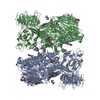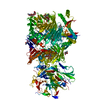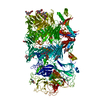+Search query
-Structure paper
| Title | Alternative splicing controls teneurin-3 compact dimer formation for neuronal recognition. |
|---|---|
| Journal, issue, pages | Nat Commun, Vol. 15, Issue 1, Page 3648, Year 2024 |
| Publish date | Apr 29, 2024 |
 Authors Authors | Christos Gogou / J Wouter Beugelink / Cátia P Frias / Leanid Kresik / Natalia Jaroszynska / Uwe Drescher / Bert J C Janssen / Robert Hindges / Dimphna H Meijer /   |
| PubMed Abstract | Neuronal network formation is facilitated by recognition between synaptic cell adhesion molecules at the cell surface. Alternative splicing of cell adhesion molecules provides additional specificity ...Neuronal network formation is facilitated by recognition between synaptic cell adhesion molecules at the cell surface. Alternative splicing of cell adhesion molecules provides additional specificity in forming neuronal connections. For the teneurin family of cell adhesion molecules, alternative splicing of the EGF-repeats and NHL domain controls synaptic protein-protein interactions. Here we present cryo-EM structures of the compact dimeric ectodomain of two teneurin-3 isoforms that harbour the splice insert in the EGF-repeats. This dimer is stabilised by an EGF8-ABD contact between subunits. Cryo-EM reconstructions of all four splice variants, together with SAXS and negative stain EM, reveal compacted dimers for each, with variant-specific dimeric arrangements. This results in specific trans-cellular interactions, as tested in cell clustering and stripe assays. The compact conformations provide a structural basis for teneurin homo- and heterophilic interactions. Altogether, our findings demonstrate how alternative splicing results in rearrangements of the dimeric subunits, influencing neuronal recognition and likely circuit wiring. |
 External links External links |  Nat Commun / Nat Commun /  PubMed:38684645 / PubMed:38684645 /  PubMed Central PubMed Central |
| Methods | EM (single particle) |
| Resolution | 3.1 - 3.9 Å |
| Structure data | EMDB-18889, PDB-8r50: EMDB-18890, PDB-8r51: EMDB-18891, PDB-8r54:  EMDB-18900: Mouse teneurin-3 non-compact subunit - A0B1 isoform  EMDB-18902: Mouse teneurin-3 non-compact subunit - A1B0 isoform  EMDB-19409: Mouse teneurin-3 compact dimer - A1B0 isoform |
| Chemicals |  ChemComp-NAG: |
| Source |
|
 Keywords Keywords | CELL ADHESION / Synaptic cell adhesion molecule / Homodimer / Cis-synaptic |
 Movie
Movie Controller
Controller Structure viewers
Structure viewers About Yorodumi Papers
About Yorodumi Papers










